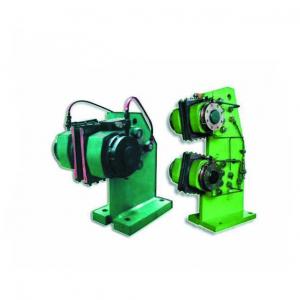

Add to Cart
materials lifting equipment safe operation Mine Hoist Disc brake
Hoist plays an important role in lifting personnel, materials and
coal. The safe operation of the hoist directly affects the safety
of underground personnel and coal production. The working
reliability of the mechanism is an important link to ensure the
safe operation of the hoist.
Disc brake is the hydraulic actuator applied in mine hoist brake
system, mainly used for JTP single cylinder 1.2m, 1.6m, 2m, 2.5m,
3M mine hoist brake device. In the elevator when starting the
hydraulic station output pressure oil on the brakes, lifting
machine to work, work brake, hydraulic station according to the
condition of increasing or decreasing pressure, brake will provide
braking force on the contrary, in the case of accidents, the
hydraulic pressure station to residual pressure, actuator with
maximum braking force in the shortest time to hoist parking
The hydraulic station is safe and control unit of mine hoist
important, it and the disc brake has a complete set of braking
system, provide pressure oil can be adjusted for disc brake, the
braking torque for different hoist, hoist the normal operation,
adjustable speed, parking mine. In any state of the accident, the
disc brake can quickly reduce the oil pressure to a predetermined
value, after the delay, the disc brake all the oil pressure quickly
return to zero. Make the hoist system in full braking state.
The lifting mechanism has two main types
1 block brake: mainly used for the old KJ and KJA series hoist,
according to its structure is divided into angular, translational,
integrated and so on
2) disc brake: nearly 20 years transplanted to the mine hoist brake
machine, with small inertia, quick action, high sensitivity,
braking torque advantage of good regulation, at present most of the
disc brake, especially in multi rope friction hoist, almost all
using disc brakes.
The Working principle of disc brake
The disc brake is produced by the disc spring, and the brake is
pressed by the hydraulic pressure. When the braking state is used,
the spring force of the disc spring group is used for the brake.
When the oil pressure is reduced to zero (the gate process), the
spring force generated by the compact disc spring pre mid shaft and
disc spring push studs to the brake shoe wear compensation effect,
positive spring force is applied the brake shoe and the brake disc
brake is attached to pressure, thereby restricting the brake disc
rotation trend. The cylinder pressure chamber filled with oil
(boost brake process), when the oil pressure is gradually increased
to the working pressure, the piston and the brake shoe connected by
oil pressure, overcome the pretightening force of disc spring and
spring compression caused the rearward displacement of piston,
through a large hollow stud, drive shaft, brake disc spring set
wear compensation stud and drives the brake shoe after the shift, a
gap is formed between the brake shoe and the brake disc, thereby
lifting the braking effect on the positive pressure of the brake
disc
The Main features of disc brakes
1) the effective area of hydraulic pressure is large, and the
pressure of the hydraulic system is medium and high pressure.
2) of the hydraulic cylinder piston and the brake shoe is not rigid
connection.
3) compensation adjustment of brake shoe and brake disc clearance
convenient, only by screwing the brake wear compensation stud can
be realized, and will not change the initial preload disc spring,
brake shoe replacement is also very convenient.
4) brake materials with high friction coefficient, good wear
resistance.
5 brake pairs of symmetrical use, the brake disc and drum will not
produce additional lateral load.
6 in normal braking, the brake can be divided into two groups,
first put into a group of work, after a certain interval of time,
and then put into the second group, to achieve a two brake.
Technical parameters:
| technical parameters | unit | Model | |||||
| TP1-40 | TP1-63 | TP1-80 | TP1-100 | TP1-2.5 | |||
| Maximum positive pressure | KN | 40 | 63 | 80 | 100 | 25 | |
| Design friction coefficient | 0.4 | ||||||
Maximum working pressure | MPa | 6.3 | 14 | 6.3 | |||
Brake shoe maximum pressure | N/cm2 | 53 | 84 | 95 | 116 | 53 | |
Brake shoe allowed temperature | ℃ | ≤210 | |||||
| Effective area of piston | Cm2 | 94 | 143.3/138 | 84.2 | 94.2 | 67 | |
| weight | Kg | 140 | 200 | 100 | |||
| Overall dimensions | mm | 490*380*297 | 490*380*297 | 515*420*296 | 515*420*296 | 490*380*297 | |
Disc spring fatigue displacement | mm | 2 | 2.5 | 3 | 2 | ||
The advantages of the rear cylinder disc brake are: compact structure, small size, adjustable performance, sensitive action, light weight, small inertia, high safety, good versatility and so on. When used in pairs, the main shaft does not bear the additional axial force, but also can be used in classification
